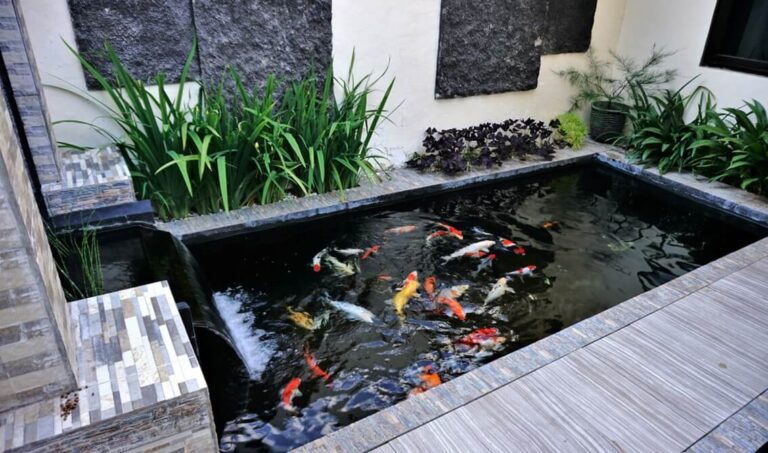Water lilies are one of the prettiest and most colorful aquatic plants. It may seem complicated, but planting water lilies are relatively straightforward. All you need is the ingredients and just the right instruction to follow.
Therefore, you need to select a perfect aquatic basket, fill it with clay-based soil, put fertilizer to boost the growth, add gravel, trim the plant a bit, and finally place the basket at the bottom of the pond.
Today’s article is all about the steps of how to plant water lilies in a deep pond. Not only that, you’ll get to know things before planting water lilies. So, keep on reading for the bonus.
Planting water lilies in a deep pond- 6 simple steps
As said before, Water lilies aren’t a difficult plant to grow in ponds. They just need warm water and sunlight to grow fast and expand. Generally, Water lilies proliferate in shallow water. The growth slows a bit when the plant is placed in deep water. Now I am going to depict the step-by-step process of planting this particular plant at the bottom of the pond.

1. Choosing a vessel
As the plant is to sit at the bottom, you’ll need a container to hold the plant and soil. Select the one that measures at least 18 inches wide and 10 inches deep.
It is better if the pot is any aquatic basket- may it be with or without drainage holes. If there are holes, you’ll need to put sacking inside the container and then proceed to the next step.
2. Filling in the pot with soil
The next step is to fill in the planting basket with soil. Clay-based garden soil is the best kind of soil to use for water lilies. You can also use heavy clay loam or packaged soil for aquatic plants.
Any kind of fluffy potting soil should be avoided because potting soil will easily drift out of the basket and leave the plant soilless. Add aquatic fertilizer pellets before you plant the lilies.
3. Trimming
The next step is to trim the plant. Before putting it in the soil, old leaves, fleshy old roots should be trimmed out from the tubers so that the energy works towards the plant’s growth.
Make sure that you don’t cut new leaves, buds, and roots while trimming.
4. Planting the tuber
Water lilies grow well when their root is firmly attached to the soil. It is better to plant the tuber at one side of the basket at about a 45-degree angle. That way, the roots will grow towards the center of the pot, and the tip will grow pointing upward.
5. Adding gravel to the soil
Another vital part of planting water lilies is adding a layer of gravel over the soil. Pea gravel or any small-sized gravel is used to reduce the risk of soil being washed away.
Adding gravel also increases the weight of the pot. That way, the pot easily gets down at the bottom.
6. Lowering the plant
The last step of the procedure is lowering the plant. It is better to put down the plant into the pond at an angle to avoid blocked air. The base should be at most 3-5 feet. Deeper than that, the plant won’t survive.
Don’t worry if the leaves are submerged; they will eventually grow and come out of water. Cool, isn’t it?

Why plant water lilies?
Water Lilies are a great choice to decorate your backyard pond. This particular plant is really useful to keep the water clean and healthy. It also provides shelter for the fish and prevents algae from growing. Plant this delicate-looking enchanter in your pond and see how it changes the look and vibe of your pond.
What should be the maximum depth?
It is an established misconception that all water lily requires deep water. The minimum needed depth for water lily planting is 1m of water. Even if you want it in shallow waters, the depth can be altered to 45-60 cms of water. The maximum depth needed to plant water lily is 3-5 feet.
To be safe, you can start putting the plant in shallow water, then replicating it in deep gradually.
The best area to plant water lilies
Water lilies like sunlight and mellowness. So, this plant grows best in the brightest place of the pond. If you do not have such a constant sunny place, make sure that place gets 3-4 hours of sunlight.
Another thing to keep in mind before planting water lily is to make sure the water is still. If the water is continuously moving, the temperature will not be the same. And as the plant likes warmth, make sure to plant water lily away from pumps and pond filters. Also, it is better for the plants if there is no waterfall installed. Moving water reduces the flowering of the plant.
But if there is a waterfall, “NEVER” plant a water lily directly under it. Because, falling water will eventually kill the plant.
When to plant water lily?
Timing also should be a matter of concern while planting water lilies in your pond. The best time to plant this beautiful flower is from mid to late spring to mid-summer. The days are warmer at that period, and the water temperature is perfect for the plant to grow.
To finish with
Water lilies are attractive and useful at the same time. They enhance the pond’s beauty as well as control the growth of pond weeds.
Congratulations! You have learned how to plant water lilies in deep ponds easily and effectively. I hope you find this piece useful and simple to follow.
Plant lilies and witness the change! Don’t hesitate to contact us if you need any to know any specific information. Good luck!






